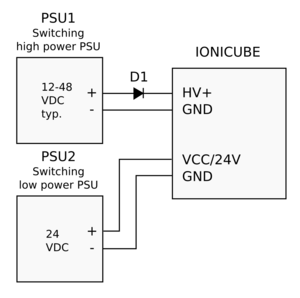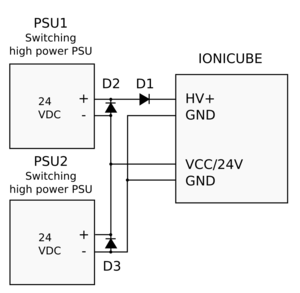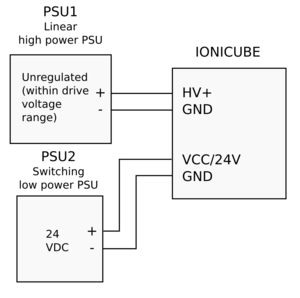Difference between revisions of "IONI power supply schemes"
From Granite Devices Knowledge Wiki
| [checked revision] | [checked revision] |
| Line 35: | Line 35: | ||
{{info|Some switching power supplies can tolerate reversed current flow from drive to PSU (renegerative current). In case of such PSU, D1 may be omitted. If unsure about PSU behavior in regeneration, always add D1.}} | {{info|Some switching power supplies can tolerate reversed current flow from drive to PSU (renegerative current). In case of such PSU, D1 may be omitted. If unsure about PSU behavior in regeneration, always add D1.}} | ||
| + | {{tip|Leaded diodes may be easiest to install right at PSU terminals, no extra wiring needed.}} | ||
[[Category:IONI_user_guide]] | [[Category:IONI_user_guide]] | ||
[[Category:IONI_wiring]] | [[Category:IONI_wiring]] | ||
[[Category:Setup_guides]] | [[Category:Setup_guides]] | ||
Revision as of 21:21, 3 December 2015
Diodes D1-D3 are typical silicon or schottky rectifier diodes that are sufficiently rated to carry the present voltages and currents. As diodes are inexpensive, there is no need to avoid oversizing them. Examples diodes:
- Diodes Inc. 10A02-T (10A 100V, leaded)
- Diodes Inc. 10A04-T (10A 400V, leaded)
- Fairchild FFPF30UP20STU (30A, 200V, leaded, isolated TO-220 case)
- Fairchild RURG3060 (30A 600V, leaded, non-isolated case - cooling tab is either anode or cathode)
- Fairchild STPS20120D (20A 120V, leaded, non-isolated case - cooling tab is either anode or cathode)
| Some switching power supplies can tolerate reversed current flow from drive to PSU (renegerative current). In case of such PSU, D1 may be omitted. If unsure about PSU behavior in regeneration, always add D1. |
| Leaded diodes may be easiest to install right at PSU terminals, no extra wiring needed. |


